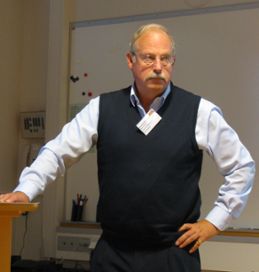A broad spectrum of climate scenarios for the future has developed over the past few years and this information is becoming increasingly available. But naturally, there are uncertainties regarding future developments, for example how vast greenhouse gas emissions will become.
How climate scenarios can be used optimally for different types of decision-making was brought to light during the Rossby Centre Day which was arranged recently at SMHI
Urgent situation

The opening speaker was Martin Parry, a world leader in the area of climate adaptation. Parry for instance played a leading role in IPCC´s latest climate evaluation.
"Just 10 years ago, we believed that we had more time to work on emissions reductions. But with developments as they are now, we see that the situation is urgent. If a successful international agreement is reached in Copenhagen in December, perhaps we will achieve maximum global heating in 20 years time.
Parry pointed out that emissions reductions in the long term will reduce warming and the climate effects, but there is still a need for considerable adaptation work to be done. Model calculations show for example that the number of people that will suffer from famine could triple throughout the world in a changed climate, to almost 1 billion.
Today, it is generally accepted that we require emissions reductions but it is also agreed that there is a need for adaptation work, among other things, from regional climate models which provide more local, high-resolution information
Arctic important area
Terry Callaghan from the Abisko Research Station has highlighted the climate over the past few years, perhaps one of the warmest periods in the northern hemisphere for several thousands of years.
During the 20th century, temperature variations can be seen, but there is a significant difference over the past few years indicating that yearly mean temperatures are creeping above the 0° line. This has consequences for the permafrost, which according to measurements has changed drastically. In turn, there is a risk that large amounts of the climate gas, methane, may leak out. In Abisko, it has also been noticed how the tree line has moved northwards and that the flora has changed.
"The Arctic is an important area to study because changes have occurred rapidly and they provide feedback for the global climate. There are 2 million people who must adapt to a warmer climate."
"Today people are adapting to the prevailing changes, for example in the reindeer industry. But more long-term planning for adaptation to future changes must take place," said Callaghan.
He pointed to the importance of cooperation between researchers and other interested parties.
"Today researchers know too little about what users need and users don´t know enough about what researchers can offer.
Ensemble new tool

Erik Kjellström, climate researcher at SMHI, presented a new tool which will help people make decisions. A new series with regional climate scenarios, a so-called ensemble, has been developed. It is one of the most important regional ensembles available today.
This is where users can see and compare the results from a number of global models down-scaled to regional levels. The ensembles also contain a number of different emissions scenarios. There is also the possibility, for example, to use individual scenarios, mean values or compare many different scenarios, depending on the user area.
"With ensembles, significantly improved opportunities are created to quantify uncertainties related to emissions scenarios, model formulations and the climate system´s natural variations."
A number of other lectures during the day highlighted further examples of climate scenarios and how they can be used, as well as future work at Rossby Centre.
More information about Rossby Centre Day is published on the Rossby Centre website.